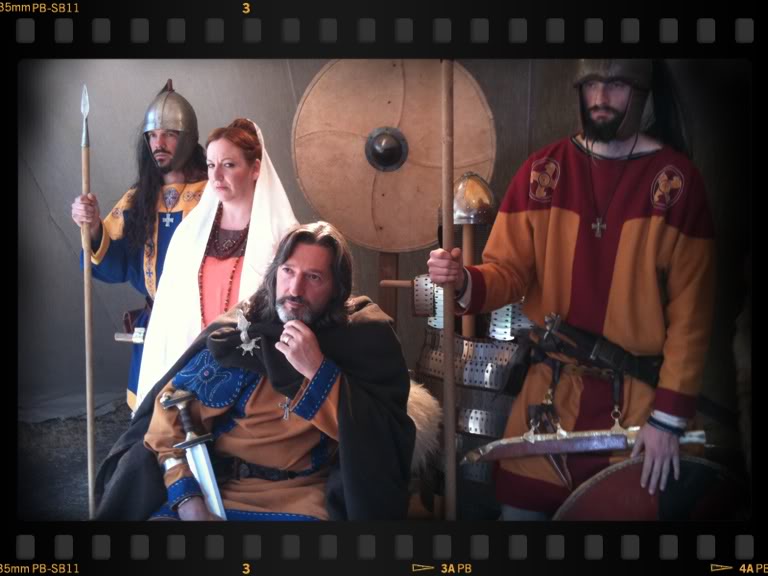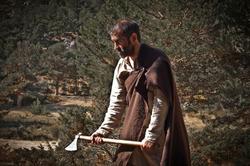| Author |
Message |
José-Manuel Benito

|
 Posted: Sun 22 Jan, 2012 5:00 am Post subject: Teaser «Dust, Sweat and Iron: Las Navas de Tolosa» Posted: Sun 22 Jan, 2012 5:00 am Post subject: Teaser «Dust, Sweat and Iron: Las Navas de Tolosa» |
 |
|
Hi.
First, I apologize for my low level of English. But would like to share some news with you.
In order to remember the most important confrontation between Muslims and Christians on the Middle Ages in Spain, during the named "Reconquista", the medieval reenactment group, "El Clan del Cuervo" (The Raven's Clan) will focusing this year on arranging various activities including, if it's possible, an historical documentary on the battle Las Navas de Tolosa (16 July 1212, ie this summer, the eighth centenary).
http://vimeo.com/35435010
Initially, since there is no funding, this association has prepared a promotional teaser to search a production company. As you can see, it has been made with little means, only with what has been able to gather by their members and friends. This is to provide a presentation for financing. If everything evolves satisfactorily, El Clan will set a film with more people, renting cameras and equipment, including digital effects, etc.
I am not a member of El Clan, but I am one of his friends, and I collaborated in the filming of this little clip. Especially in the shots of Pallatium of the last king of visigoths, Ruderic (710-711 c.e.), and later Christian chroniclers. As you can see here (I have some pride, and let me thank El Clan for letting me be in these scenes).
http://vimeo.com/33513552
I don't have experience in the Historical Reenactment, in fact I'm a newbie coming from the world of archeology and teaching. In Spain, the Medieval Reenactment has become popular recently, and the average level is lower than the rest of Europe. While is not the only one, El Clan del Cuervo is one of the most rigorous, and self-demanding groups, in my country.
I invite you to visit their web-site: http://www.clandelcuervo.com/
The title of teaser, «Polvo, Sudor y Hierro» (Dust, Sweat and Iron), is not inspired by the words of Churchill, but in a poetic composition of 1901, by Manuel Machado (1874-1947), brother of one of greatest Spanish poets in 20th century (Antonio Machado). Manuel was poet too, though less valued:
El ciego sol, la sed y la fatiga.
Por la terrible estepa castellana,
al desierto, con doce de los suyos
-polvo, sudor y hierro-, el Cid cabalga.
Some pictures:

Concept-art of visigoth pallatium, by Yeyo Balbás.

The result, with king Rudericus and its gardingi.

A member of El Clan as example of what the title means.
Best regards
Ecce, iam meum patrem video
Ecce, iam meam matrem video
Ecce, iam meas sorores ac meos fratres video
Ecce, iam meam gentem totam ab initio video
Ecce illi me iam vocant
Et illi me rogant meum locum inter se accipere
Apud Averni portas sunt
Ubi viri fortes ćterne vivant
Last edited by José-Manuel Benito on Tue 24 Jan, 2012 6:53 am; edited 2 times in total
|
|
    |
 |
Randall Moffett

|
 Posted: Sun 22 Jan, 2012 6:11 pm Post subject: Posted: Sun 22 Jan, 2012 6:11 pm Post subject: |
 |
|
Las Navas would make an interesting project. I have researched some Iberian history though largely the 14th century and find it one of the more colorful places in Europe of the time.
The video is very interesting. I'd be interested in what you plan on doing in this documentary and your strategy on covering such a large and dramatic event. Will you be looking for more groups to help you in this? Are there many groups that portray the Almohads in the area? There were several other European groups present if I remember correctly so you might be able to find help from some other European groups.
Looks really neat and it could be a fun project. The scribe scenes look good. Was the music from Kingdom of Heaven?
Is Caliph Nasir's tents really on display in Spain still? I heard this years ago but have never had it verified.
Keep us posted on your progress.
RPM
|
|
  |
 |
José-Manuel Benito

|
 Posted: Mon 23 Jan, 2012 10:19 am Post subject: Posted: Mon 23 Jan, 2012 10:19 am Post subject: |
 |
|
Thanks.
I'll try to answer all the questions, but not easy for me.
The fourteenth-century, in Iberian peninsula is very interesting, but also, very complex, because there was a great crisis in economics, politics and society. Most striking, apart from the Black Death, are the civil wars, that are separate but related to the Hundred Years War (for instance, in Castile fought Bertrand du Guesclin against the Black Prince, in support of two brothers-enemies who claimed the throne).
Regarding the activities we want to do in order to commemorate the eighth centenary of the Battle of Las Navas de Tolosa, under the coordination of El Clan del Cuervo, we have ruled out making a big event, such Hastings, because the economic situation in Spain is very serious.
I can't talk in the name of the Organizers, but It has been thought to make a humble presentation, perhaps in Toledo, where is the Army Museum. We want offer quality over quantity. In fact, the documentary is our most ambitious bet.
But, there are other groups who have different ideas, and also try to commemorate the Battle. If you are interested in an event with many participants from all over Spain, including several countries, you can consider the Battle Honnours project, whose link I put below. You can see pictures of the last meeting and judge for yourself.
http://www.battlehonours.es/modules.php?op=mo...mp;gid=397
Unfortunately, there are no people who do quality Reenactment of muslims in the Middle Ages on Spain, nor almohads, nor andalusian muslims, before the end of the 14th century to the 15th century (Nasrid kingdom of Granada). It's sad, but, in general, moorish-reenactors on Spain are like-Hollywood types.
Also, in Western Europe there are not Reenactment groups for andalusian or north african moorish of the Middle Ages.
| Randall Moffett wrote: | Is Caliph Nasir's tents really on display in Spain still? I heard this years ago but have never had it verified.
Keep us posted on your progress.
RPM |
No, isn't. It's true that for a long time, a large piece of muslim tapestry, that is preserved at Las Huelgas Museum, was wrong identified as a part of the tent of the almohad caliph Muhámmad al-Násir. It was believed that was part of the plunder gained by christian kings in the battle of Las Navas. But, recent research has rejected this attribution.

In fact, this magnificent tapestry was obtained years later, when the king of Castile and Leon, Ferdinand III, wins the city of Seville in 1248 (Jerrylin D. Dodds, 1992: Al-Andalus: the Art of Islamic Spain, Catalogue of the exposition, Granada, Alhambra/New York, The Metropolitan Museum of Art, 1992, New York; p. 326-327, n° 92. I have the Spanish edition).
Regards
Ecce, iam meum patrem video
Ecce, iam meam matrem video
Ecce, iam meas sorores ac meos fratres video
Ecce, iam meam gentem totam ab initio video
Ecce illi me iam vocant
Et illi me rogant meum locum inter se accipere
Apud Averni portas sunt
Ubi viri fortes ćterne vivant
|
|
    |
 |
|
|
You cannot post new topics in this forum
You cannot reply to topics in this forum
You cannot edit your posts in this forum
You cannot delete your posts in this forum
You cannot vote in polls in this forum
You cannot attach files in this forum
You can download files in this forum
|
All contents © Copyright 2003-2025 myArmoury.com — All rights reserved
Discussion forums powered by phpBB © The phpBB Group
Switch to the Basic Low-bandwidth Version of the forum
|

